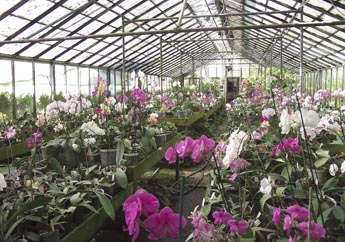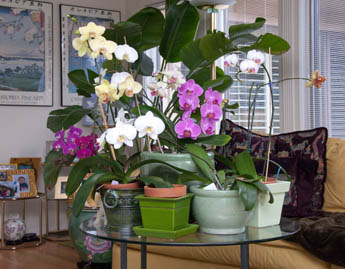It looks so lovely and exotic sitting there on the book case. Wonder how long the flowers will last? Will it ever flower again? The plant is not much to look at without flowers, is it? First impressions such as these usually accompany that first orchid plant received as a gift. First of all, welcome to what is probably one of the world's most rewarding avocations. Yes, "avocations." There are very few who begin with orchids who do not find it a lifelong love affair.
To better understand care and maintenance of the gift plant, it will be helpful to trace just how that plant came to you. Chances are very slight that the plant has come directly from where it was grown. Most orchid nurseries do offer gift plants, usually in bud to bloom soon, to be shipped direct via common carrier. But it is much more likely that a secondary or tertiary supplier has been involved. Many of the flowering orchid plants that ultimately reach the "public at large" are grown by large nurseries that are not accessible for direct purchase � either by design (intentionally) or location. Plants may either be shipped in bud for relatively quick turnover, or may be sold at some earlier stage to an intermediate grower who will bring them into bud and subsequently market them directly or indirectly.

Traditionally, smaller orchid growers served as the final step between the larger wholesale grower and the public. Flowering orchid plants would be made available both for on-site purchase at the nursery and at smaller, local orchid shows. This type of market still accounts for a good share of indirect sales, especially for products grown by the intermediate-size wholesale growers who cannot supply larger markets. Florists have also been one of the more traditional outlets for flowering orchid plants, although because of their low volume, they have not had access to the larger growers. More recently, two higher volume markets have begun to be exploited. These are the "green plant" section of supermarkets and the growing number of garden center chains.
How does this chain of supply affect your plant? The bottom line is that the plant that you are enjoying has not been obtained fresh off of the bench on which it was grown; it has been packed, shipped, and unpacked at least once and possibly several times before reaching you. So, while it will still have a flower-life expectancy at least equal to that of most other flowering plants, it will probably not last to its full potential. The question then becomes how best to maximize flower-life in your home.
Orchid plants are, in general, sturdy and forgiving of neglect. However, their flowers are subject to bruising and other damage. It is a good idea first to examine the general condition of the plant and blooms. Remember, if the plant has been shipped to you by common carrier, it is less likely to have open flowers than if hand-delivered and will usually have buds to open shortly.

The foliage should be firm (turgid) and unbroken. If the foliage is limp, and doesn't respond to watering, the plant has probably lost its roots. Root loss can also be brought on by temperature extremes in transit, especially if the plant is wet. The plant may be salvageable by removing the flower spike and increasing humidity in the immediate area, but the floral display is lost. If the foliage is slightly damaged, the plant will not suffer except in terms of appearance, so there is no cause for great worry.
Flowering orchid plants are best kept in a relatively bright and airy location and should not be allowed to dry out while in the home. Prevent direct sunlight from striking the leaves. Heat, whether from heat registers or otherwise, is the enemy of orchid flowers. Overly warm temperatures are almost always associated with low humidity and this will cause accelerated flower aging. If house plants are already being grown, placing the flowering orchid plant in the same area will not only make a nice display, but make the orchid plant happier due to the microclimate created by the collective transpiration.  For maximum flower life, try to maintain orchid plants at an even moisture level. The should never be sopping wet (do not place pots directly on a saucer of water!), but they should not be allowed to get bone dry either. The potting media should be moist enough to be springy and leave a residue on your finger when pressed into it. Blooming orchids do not need to be fertilized because they already have expended the energy required to produce flowers. It is a good idea to give them a rest, allow them to approach dryness, after the flowers have faded.
For maximum flower life, try to maintain orchid plants at an even moisture level. The should never be sopping wet (do not place pots directly on a saucer of water!), but they should not be allowed to get bone dry either. The potting media should be moist enough to be springy and leave a residue on your finger when pressed into it. Blooming orchids do not need to be fertilized because they already have expended the energy required to produce flowers. It is a good idea to give them a rest, allow them to approach dryness, after the flowers have faded.
The best news is the same for orchids as it is for most plants grown in the home: it is more a matter of letting them grow than getting them to grow.

